Gamma Ray Bursts
GRB 160821A
TITLE: GCN CIRCULAR
NUMBER: 19832
SUBJECT: GRB 160821A: TAROT Calern observatory optical detection
DATE: 16/08/21 22:38:49 GMT
FROM: Bruce Gendre at ASDC <bruce.gendre@gmail.com>
Gendre B. (UVI - Etelman Obs.), Klotz A., Turpin D., Atteia J.L.
(CNRS-OMP-IRAP), Boer, M., Laugier, R. (CNRS-ARTEMIS) report:
We imaged the field of GRB 160821A detected by SWIFT
(trigger 709351) with the TAROT robotic telescope (D=25cm)
located at the Calern observatory, France.
The observations started 29.31min after the GRB trigger.
The elevation of the field decreased from
10 degrees above horizon and weather conditions
were fair.
We detect a new fading source in the error box given by SWIFT (Siegel et
al., GCNC 19830) at the following position (+/- 3 arcsec):
RA(J2000.0) = 11h 25m 01.6s
DEC(J2000.0) +42d 20' 05"
OT was R~15.4 at 29.31min after GRB. Due to the brightness of the event,
we encourage any follow-up.
Magnitudes were estimated with the nearby USNO-B1 stars
and are not corrected for galactic dust extinction.
N.B. Galactic coordinates are lon=166.5065 lat=+66.7370
and the galactic extinction in R band is 0.1 magnitudes
estimated from D. Schlegel et al. 1998ApJ...500..525S.
This message may be cited.
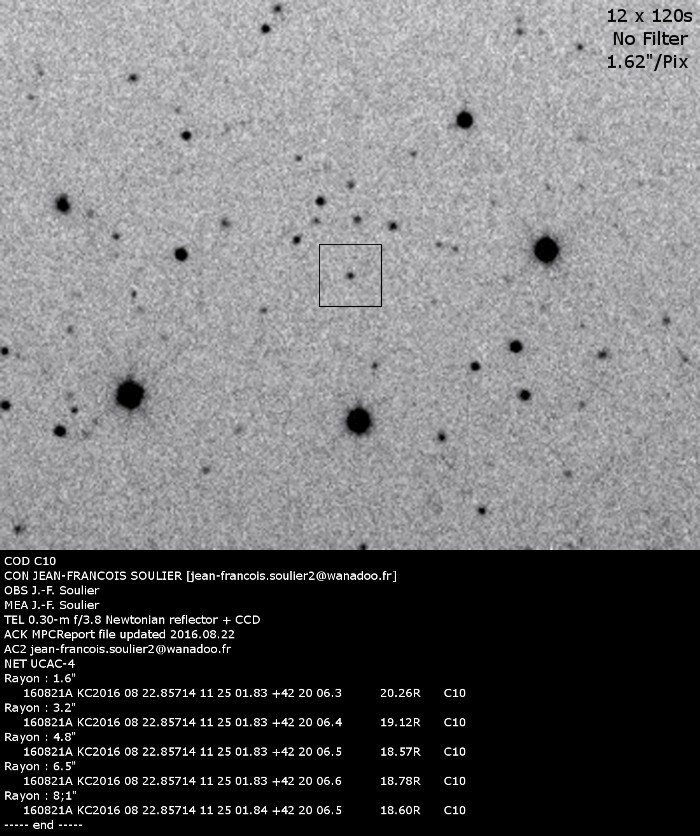
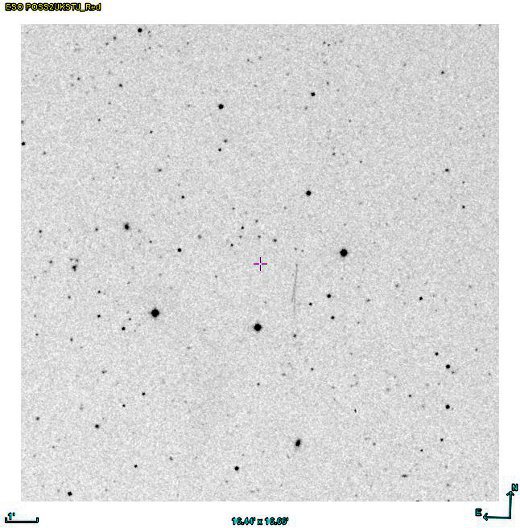

----------------------------------------------------------------------
GRB 160821A: Maisoncelles observatory optical observations
----------------------------------------------------------------------
Soulier J.-F. (Observatoire de Maisoncelles, France) reports:
We imaged the field of GRB 160821A detected by SWIFT
(trigger 709351) with the Newtonian 30cm F/3.8 telescope
located at the Maisoncelles observatory, France (IAU C10).
We detected the optical transcient described by Gendre et al.
(GCNC 19832) at the following position (+/- 0.5 arcsec):
RA(J2000.0) = 11h 25m 01.83s
DEC(J2000.0) +42d 20' 06.5"
Filter T_start(d) T_stop(d) Exp(s) R
None 0.992 1.008 1440 18.6
None 4.992 4.008 1440 >20
Taking account for the magnitude provided by Gendre et al.
(GCNC 19832) we derived an optical decay alpha=0.78
Magnitudes were estimated with the nearby UCAC-4 stars
and are not corrected for galactic dust extinction.
GRB
130427A
Observations of
20130428.851 at 20130428.880, by C10
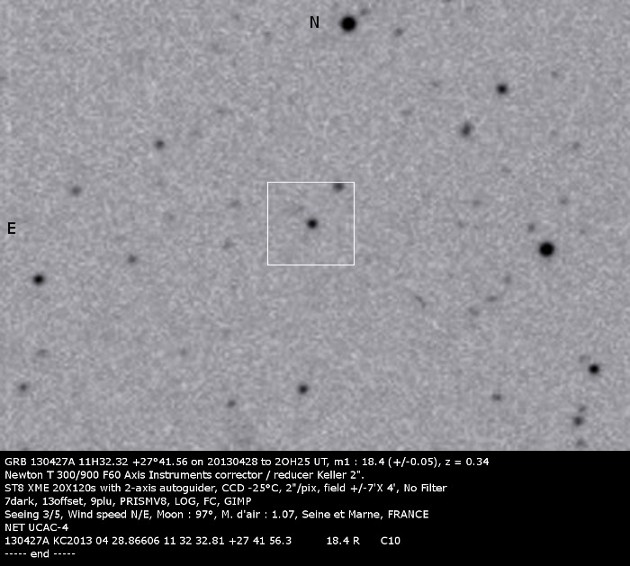

T300NC F/D : 3
ST8XME
Correcteur/Réducteur Keller 2’’
Pas de filtre employé
T° capteur : -25°c
Auto guidage deux axes employé, bing 2X2
Traitements images : 7 darks, 13 Offset, 9 PLU.
Acquisitions du 20130428.851 au 20130428.880, soit 20x120s, Seine et Marne (77)
Angle horaire : DEBUT -00H26m E FIN +00H17m O
M.d'air : DEBUT 1.071 FIN 1.072
Hauteur : DEBUT 68°.3 FIN 68°.7
Azimuth : DEBUT 164°.0 FIN 190°.1
Echant. : 2.031"/pix
Champ : 51‘.4 par 34’.3
Elongation Lunaire en début de pose : 97°
Seeing : 3/5
Vent N/E faible
Ciel clair
Mesure sous ASTROMETRICA :
Rayon d'ouverture de 8.1", m2 : 18.4 (+/-0.05) UCAC-4
TEL 0.30-m f/3 Newtonian reflector + CCD
NET UCAC-4
130427A KC2013 04 28.86606 11 32 32.81 +27 41
56.3 18.4
R C10
----- end -----
Observations of
20130501.856 at 20130501.931, by C10
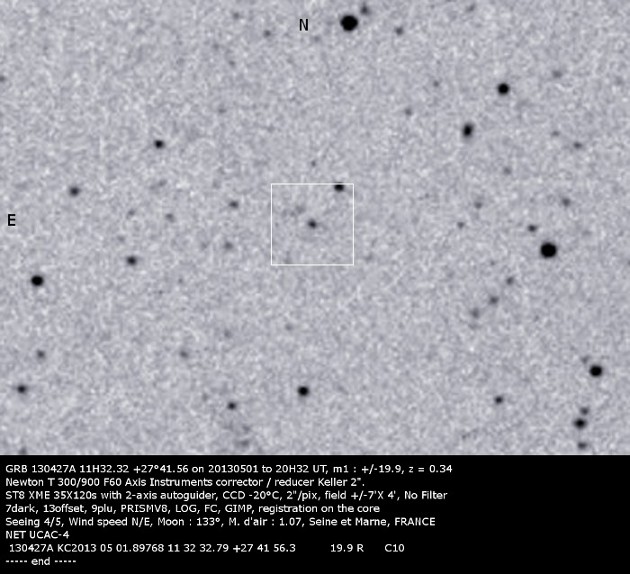
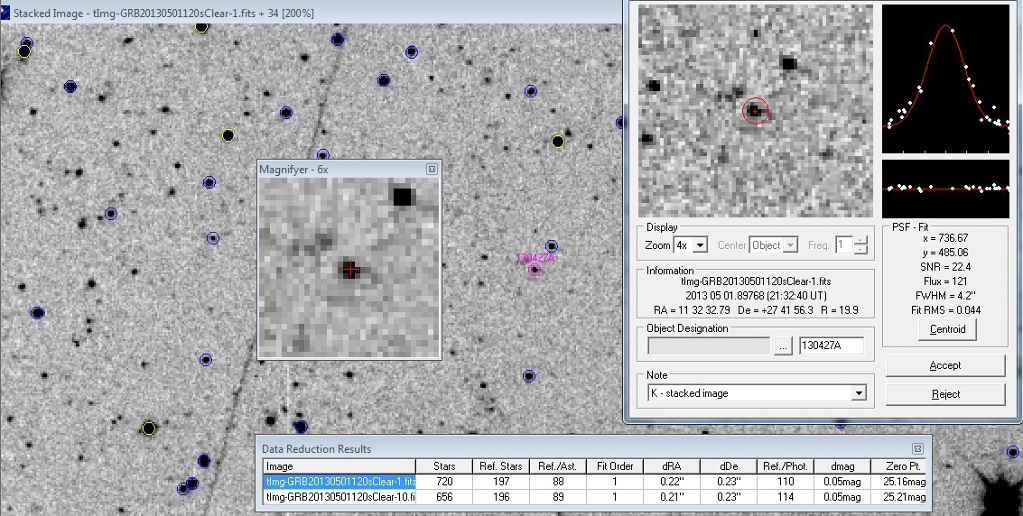
T300NC F/D : 3
ST8XME
Correcteur/Réducteur Keller 2’’
Pas de filtre employé
T° capteur : -20°c
Auto guidage deux axes employé, bing 2X2
Traitements images : 7 darks, 13 Offset, 9 PLU.
Acquisitions du 20130501.856 au 20130501.931.
Soit cliché "B" = 35x120s, cliché "A" = 15X120s, Seine et Marne (77)
Angle horaire : DEBUT -00H07m E FIN +01H41m O
M.d'air : DEBUT 1.071 FIN 1.13
Hauteur : DEBUT 68°.9 FIN 61°.3
Azimuth : DEBUT 175°.6 FIN 231°.9
Echant. : 2.031"/pix
Champ : 51‘.4 par 34’.3
Elongation Lunaire en début de pose : 133°
Seeing : 4/5
Vent N/E faible
Ciel NUAGEUX
Mesure sous ASTROMETRICA :
Rayon d'ouverture de 6.1", m2 : 19.9 UCAC-4
TEL 0.30-m f/3 Newtonian reflector + CCD
NET UCAC-4
130427A KC2013 05 01.89768 11 32 32.79 +27 41 56.3 19.9 R C10
----- end -----
Observations of
20130505.857 at 20130505.902, by C10
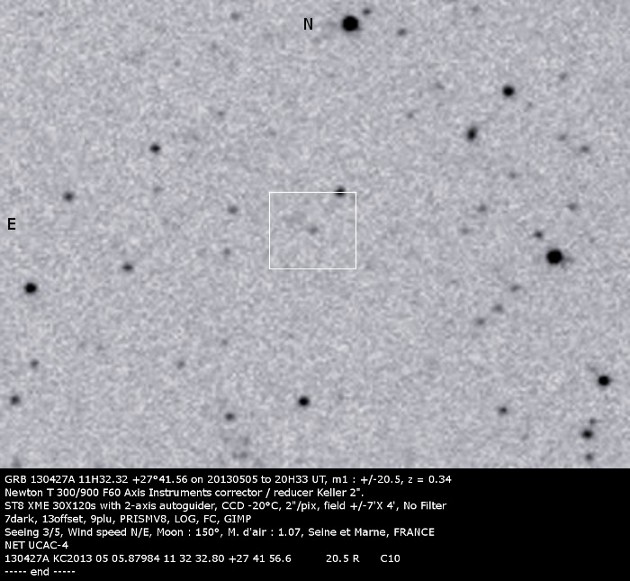
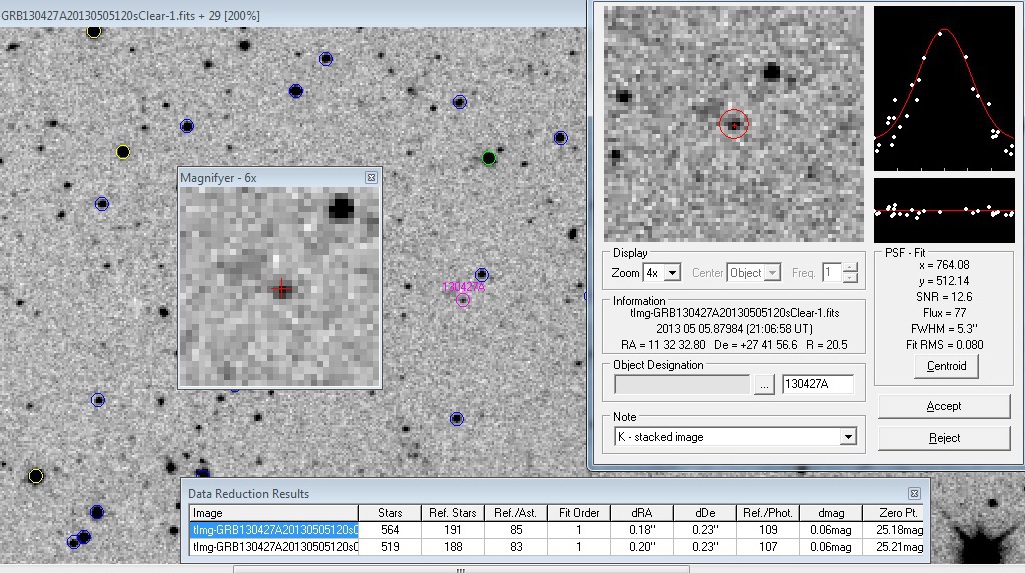
T300NC F/D : 3
ST8XME
Correcteur/Réducteur Keller 2’’
Pas de filtre employé
T° capteur : -20°c
Auto guidage deux axes employé, bing 2X2
Traitements images : 7 darks, 13 Offset, 9 PLU.
Acquisitions du 20130505.857 au 20130505.902.
Cliché = 30X120s, Seine et Marne (77)
Angle horaire : DEBUT +00H10m E FIN +01H15m O
M.d'air : DEBUT 1.071 FIN 1.10
Hauteur : DEBUT 68°.8 FIN 64°.4
Azimuth : DEBUT 186°.3 FIN 221°.4
Echant. : 2.031"/pix
Champ : 51‘.4 par 34’.3
Elongation Lunaire en début de pose : 150°
Seeing : 3/5
Vent N/E NUL
Ciel clair
Mesure sous ASTROMETRICA :
Rayon d'ouverture de 8.1", m2 : 20.5 (+/- 0.06) UCAC-4
TEL 0.30-m f/3 Newtonian reflector + CCD
NET UCAC-4
130427A KC2013 05 05.87984 11 32 32.80 +27 41
56.6 20.5
R C10
----- end -----
Observations of
20130507.859 at 20130507.925, by C10
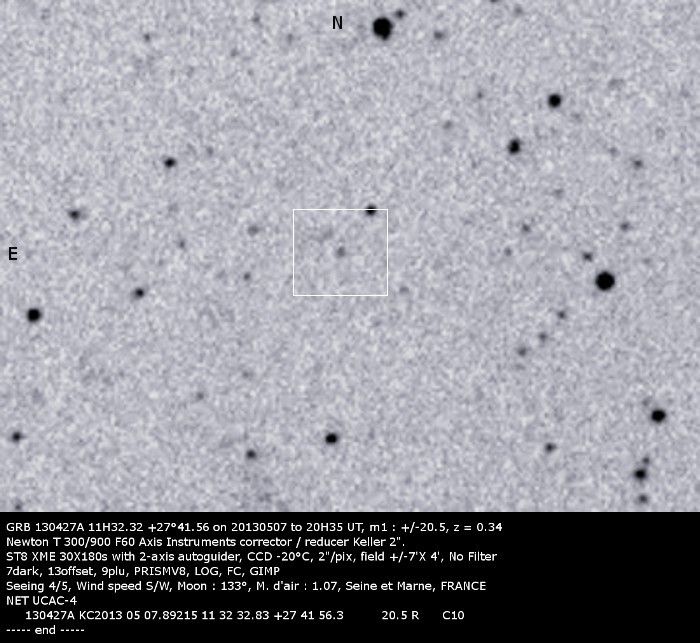
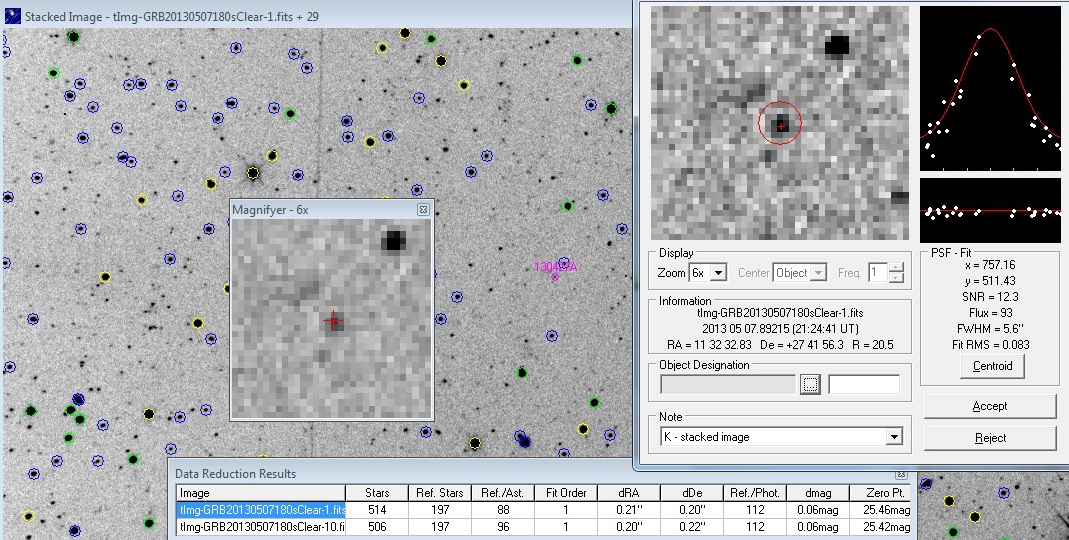
T300NC F/D : 3
ST8XME
Correcteur/Réducteur Keller 2’’
Pas de filtre employé
T° capteur : -20°c
Auto guidage deux axes employé, bing 2X2
Traitements images : 7 darks, 13 Offset, 9 PLU.
Acquisitions du 20130507.859 au 20130507.925.
Cliché = 30X180s, Seine et Marne (77)
Angle horaire : DEBUT +00H20m E FIN +01H56m O
M.d'air : DEBUT 1.073 FIN 1.16
Hauteur : DEBUT 68°.6 FIN 59°.4
Azimuth : DEBUT 192°.4 FIN 237°.1
Echant. : 2.031"/pix
Champ : 51‘.4 par 34’.3
Elongation Lunaire en début de pose : 133°
Seeing : 4/5
Vent S/W faible
Ciel clair mais brumeux
Mesure sous ASTROMETRICA :
Rayon d'ouverture de 6.1", m2 : 20.5 (+/- 0.06) UCAC-4
NET UCAC-4
130427A KC2013 05 07.89215 11 32 32.83 +27 41
56.3 20.5
R C10
----- end -----
 Credit NASA
Credit NASA
GRB
120326A
Start date
of GRB :
2012-03-26T01:20:28.895
Flyers GCN : http://gcn.gsfc.nasa.gov/other/120326.gcn3
Equatorial
coordinates : J2000.0 : 18:15:37.13 +69:15:35.7
A rapid photometric analysis suggests that the magnitude remains constant at about R =
19.5
during the three hours that followed the gamma-ray burst. This
is not the usual behavior
of an optical emission.
Image obtained
with TAROT (sum of 46 images) :
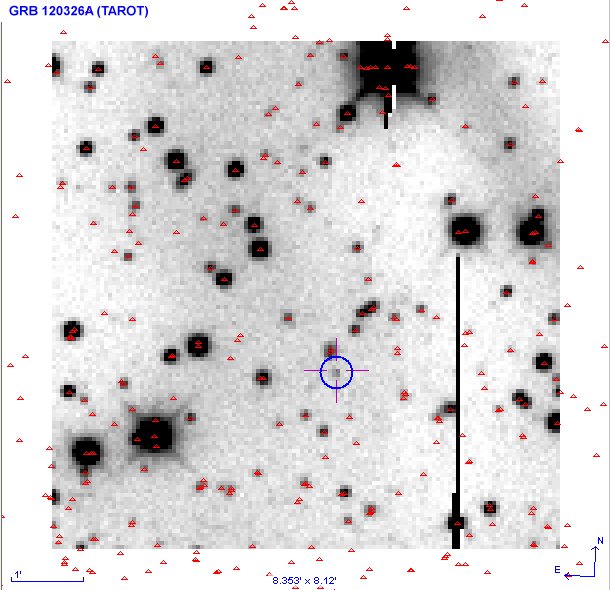
Message from Alain Klotz AUDE on
the list.
The
GTC gave a redshift z = 1798,
so we
can
estimate its distance to 10 billion
light years. The
universe was only 3.7
billion years when the explosion occurred.
////////////////////////////////////////////////////////////////////////
TITLE: GCN CIRCULAR
NUMBER: 13126
SUBJECT: GRB 120326A: Maisoncelles Observatory optical observations
DATE: 12/03/27 04:40:33 GMT
FROM: Alain Klotz at CESR-CNRS <Alain.Klotz@free.fr>
Soulier J.-F. (Observatoire de Maisoncelles) reports
the observation of the afterglow of GRB 120326A
19.7 hours after the GRB using a 30cm F/4 telescope
at the Observatoire de Maisoncelles, France (IAU
observatory code is C10).
A CCD camera ST7XME and no filter were
used. A stack of images shows clearly the
presence of the afterglow that confirms the
rebrightening mentioned by Gorosabel et al.
(GCNC 13112):
Tgrb +
start end Rmag error
19.7h 20.7h 18.6 0.1
We used the star NOMAD1 1593-0145121
(ra,dec)=(273.9707306,+69.3063278)
as reference R=15.32. Magnitudes are not
corrected for galactic dust extinction.
////////////////////////////////////////////////////////////////////////
Observations of
20120326.880 at 20120330.177, by C10

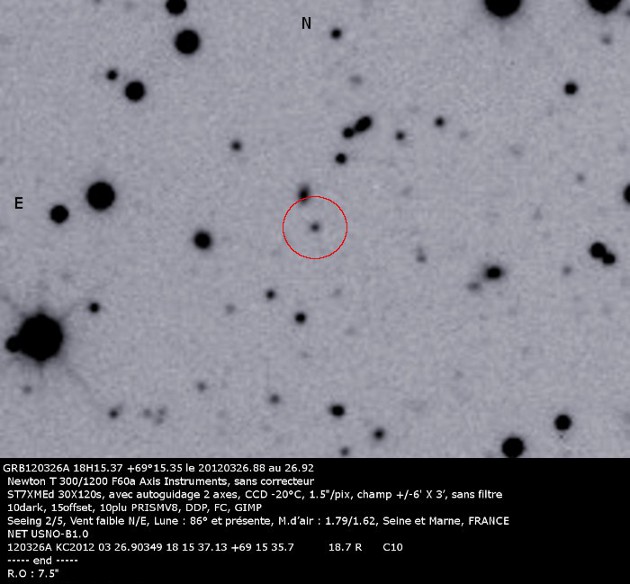
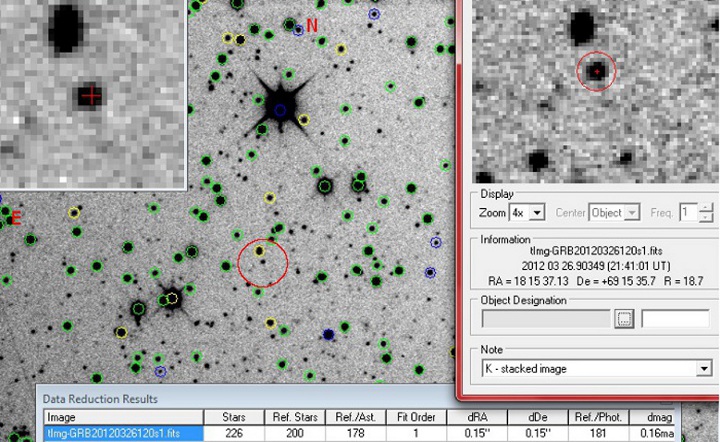
T300NC F/D : 4
ST7XME.d
pas de correcteur
pas de filtre employé
T° capteur : -20°c
Auto guidage deux axes employé
Traitements images : 10 darks, 15 Offset, 10 PLU.
Acquisitions du 20120326.880 au 20120326.92
Angle horaire : DEBUT -08H35E FIN -07H31E
M.d'air : DEBUT 1.79 FIN 1.62
Hauteur : DEBUT 33°.7 FIN 37°.8
Azimuth : DEBUT 19°.3 FIN 24°.3
Echant. : 1.547"/pix
Champ : 19'.43 par 13'.09
Elongation Lunaire en début de pose : 86° et présente
Seeing : 2/5
Vent N/E faible à nul
Ciel clair
Mesure sous ASTROMETRICA :
NET USNO-B1.0
120326A KC2012 03 26.90349 18 15 37.13 +69 15
35.7 18.7
R C10
----- end -----
Rayon d'ouverture de 7.5", m2 : 18.7 (+/- 0.17)
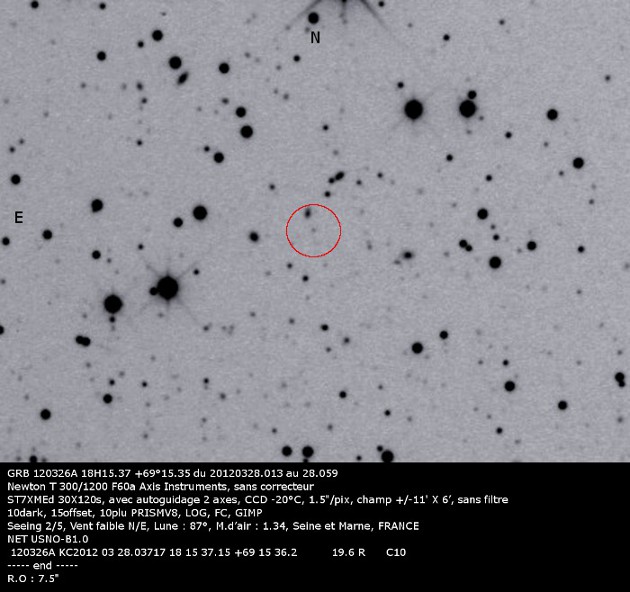
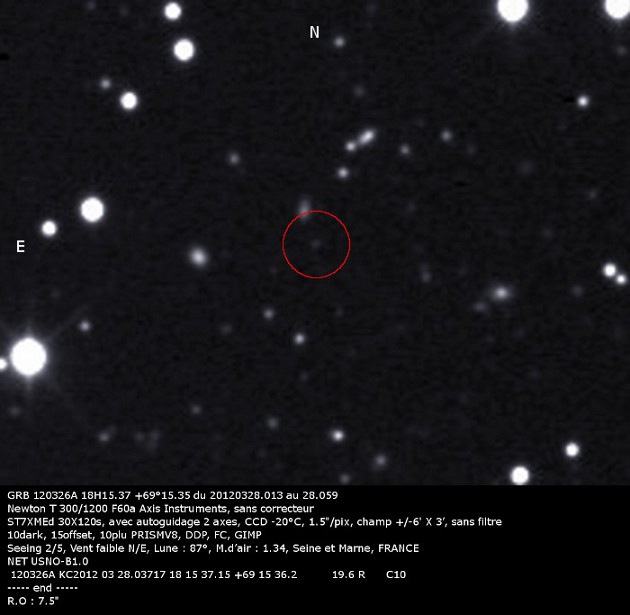
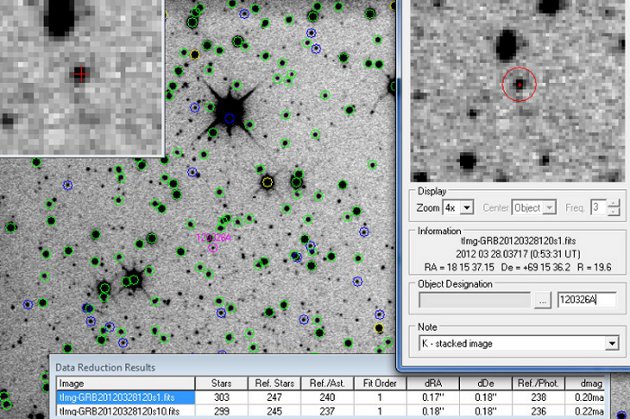
T300NC F/D : 4
ST7XME.d
pas de correcteur
pas de filtre employé
T° capteur : -20°c
Auto guidage deux axes employé
Traitements images : 10 darks, 15 Offset, 10 PLU.
Acquisitions du 20120328.013 au 20120328.059
Angle horaire : DEBUT -05H20E FIN -04H13E
M.d'air : DEBUT 1.34 FIN 1.23
Hauteur : DEBUT 47.9° FIN 53.9°
Azimuth : DEBUT 31.3° FIN 32.39°
Echant. : 1.547"/pix
Champ : 19'.43 par 13'.09
Elongation Lunaire en début de pose : 87°
Seeing : 2/5
Vent N/E faible
Ciel clair
Mesure sous ASTROMETRICA :
NET USNO-B1.0
120326A KC2012 03 28.03717 18 15 37.15 +69 15
36.2 19.6
R C10
----- end -----
Rayon d'ouverture de 7.5", m2 : 19.6 (+/- 0.18)
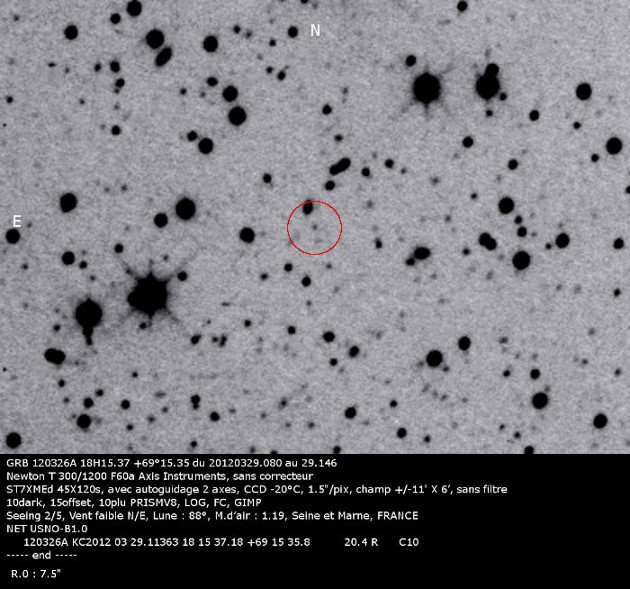
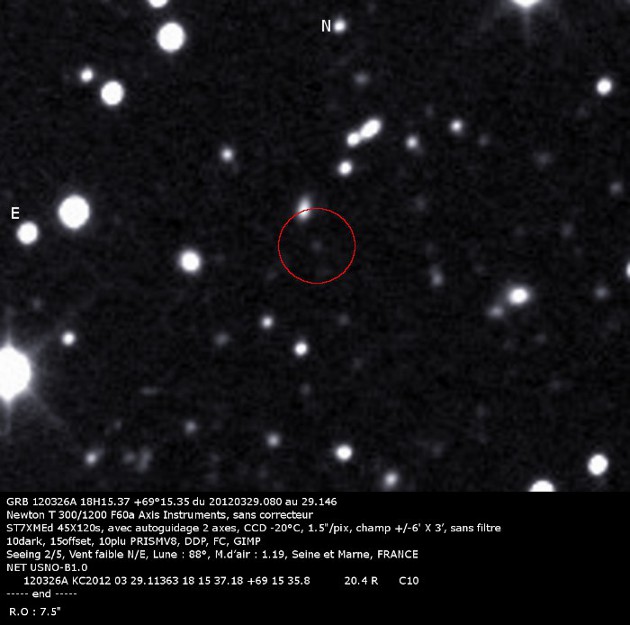
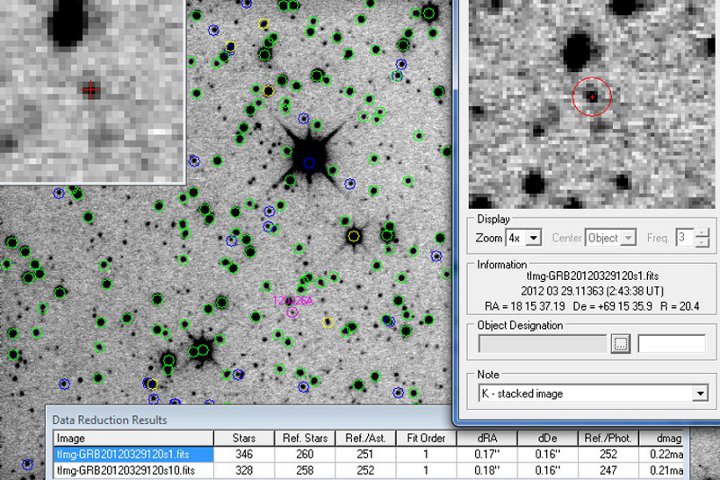
T300NC F/D : 4
ST7XME.d
pas de correcteur
pas de filtre employé
T° capteur : -20°c
Auto guidage deux axes employé
Traitements images : 10 darks, 15 Offset, 10 PLU.
Acquisitions du 20120329.080 au 20120329.146
Angle horaire : DEBUT -03H40E FIN -02H03E
M.d'air : DEBUT 1.19 FIN 1.10
Hauteur : DEBUT 56.8° FIN 64.6°
Azimuth : DEBUT 31.9° FIN 24.9°
Echant. : 1.547"/pix
Champ : 19'.43 par 13'.09
Elongation Lunaire en début de pose : 88°
Seeing : 2/5
Vent N/E faible
Ciel clair
Mesure sous ASTROMETRICA :
NET USNO-B1.0
120326A KC2012 03 29.11363 18 15 37.18 +69 15
35.8 20.4
R C10
----- end -----
Rayon d'ouverture de 7.5", m2 : 20.4 (+/- 0.21)
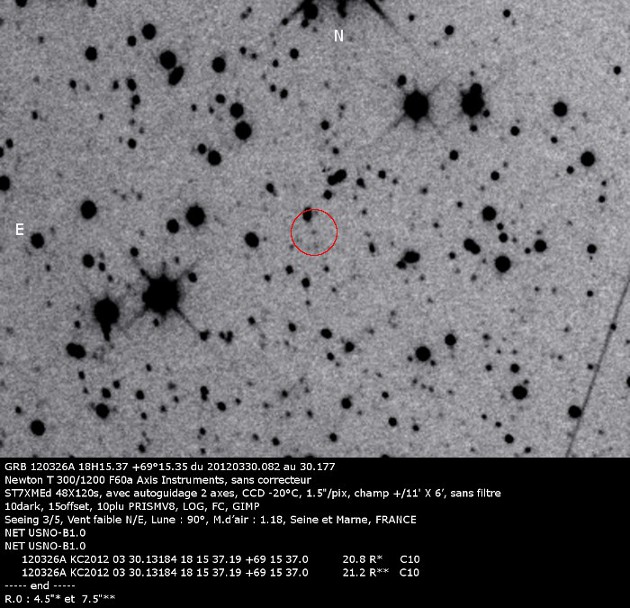
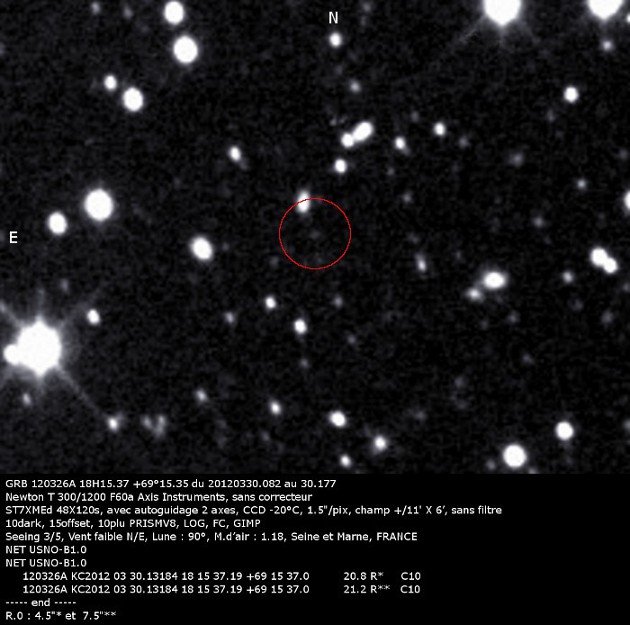
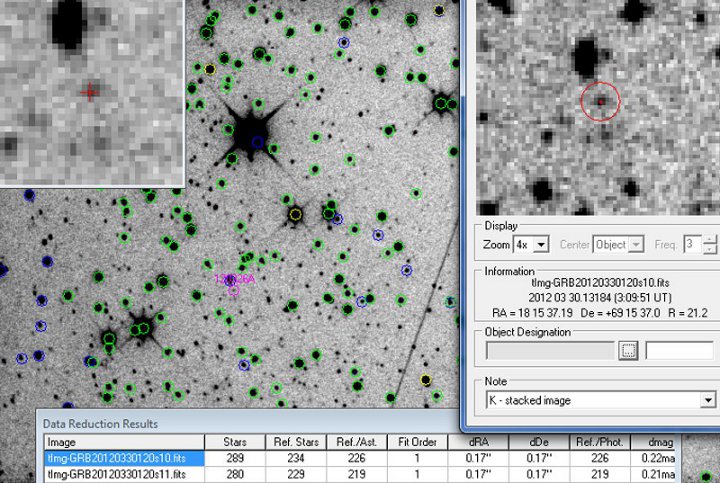
T300NC F/D : 4
ST7XME.d
pas de correcteur
pas de filtre employé
T° capteur : -20°c
Auto guidage deux axes employé
Traitements images : 10 darks, 15 Offset, 10 PLU.
Acquisitions du 20120330.082 au 20120330.177
Angle horaire : DEBUT -03H33E FIN -001H15E
M.d'air : DEBUT 1.18 FIN 1.08
Hauteur : DEBUT 57.4° FIN 67.5°
Azimuth : DEBUT 31.7° FIN 17.2°
Echant. : 1.547"/pix
Champ : 19'.43 par 13'.09
Elongation Lunaire en début de pose : 90°
Seeing : 3/5
Vent N/E faible
Ciel clair/Passage de Cirrus
Mesure sous ASTROMETRICA :
NET USNO-B1.0
120326A KC2012 03 30.13184 18 15 37.19 +69 15
37.0 21.2
R C10
----- end -----
Rayon d'ouverture de 7.5", m2 : 21.2 (+/- 0.2)
NET USNO-B1.0
120326A KC2012 03 30.13184 18 15 37.19 +69 15
37.0 20.8
R C10
----- end -----
Rayon d'ouverture de 4.5", m2 : 20.8 (+/- 0.2)
For more
information:
Lecture Tuesday, October 5, 2004 by Robert Mochkovitch.
GRBs are the most violent explosions occurring in the universe (after the
Big Bang !).
They were discovered in the late sixties by U.S. spy satellites monitoring Soviet nuclear explosions.
For over
twenty-five years
they remained unknown distance before being observed in 1997
late optical emission continuing after the jump for several weeks.
These "ghosting" allowed, spectroscopy, to show that the bursts are located at
billion light years and must radiate a gigantic
power.
Understanding of GRBs is one of
the great challenges today to astronomers.
http://www.cerimes.fr/le-catalogue/les-sursauts-gamma-les-plus-violentes-explosions-de-lunivers.html
Je rappelle que :
"toutes les images et textes de ce site sont protégés
par les lois internationales sur le copyright
et ne peuvent être utilisés, sous
quelque forme que ce soit, sans une autorisation écrite de son auteur".
I recall that : "All images and text from my site are protected by international law
copyright and may not be used in any form whatsoever without
written permission of its author".
























